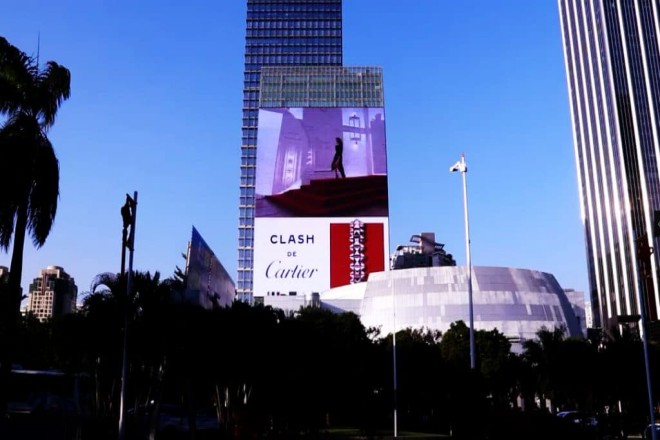介绍

LED显示屏 以其高亮度、清晰度、节能等特点在信息显示领域大放异彩。
户外与半户外LED显示屏因使用环境和性能要求的不同,显示出各自独特的优势,本文旨在详细分析二者的主要区别,为读者的选择提供有价值的参考。
1、户外LED显示屏、半户外LED显示屏的定义
2、户外LED显示屏与半户外LED显示屏的区别
1). 制造工艺的差异
1.1).户外LED显示屏:
- 复杂工艺:
制作工序颇为讲究,首先要将内部电子元器件进行注胶,这一步是为了加强显示器的防水防尘性能,确保在户外恶劣环境下稳定工作。
填胶之后,这些部件被组装到一个全封闭的盒子里,不仅坚固耐用,还能进一步保护显示器免受外界环境的影响。
- 高品质材料:
由于长期暴露在户外,所用材料经过特殊挑选,确保可以承受高温、低温、潮湿、紫外线等挑战。
1.2).半户外LED显示屏:
- 简化流程:
相对于户外屏来说,半户外屏的制作工艺相对简单,通常不需要灌胶,这是因为它们安装在相对有遮挡的环境中,比如车棚、天桥下等,所以对外界环境的抵抗力没那么高。
- 成本效益:
由于没有复杂的灌胶工艺和高级别防护要求,半户外屏成本通常较低,更适合预算有限,但对显示效果有一定要求的应用场景。
2).防水性能的差异
2.1).户外LED显示屏:
- 完全防水设计:
户外屏必须具备较高的防水性能,防止雨雪等液体渗透而造成电路短路或损坏,通常会采用IP65或者更高的防水等级标准,保证在各类恶劣天气下正常工作。
2.2).半户外LED显示屏:
- 中度防水:
半户外屏虽然不需要像户外屏那样完全防水,但是仍然需要能够抵抗一定程度的湿度和潮湿。
一般来说,半户外屏的防水等级会低于户外屏,但依然足以应对大部分半遮蔽环境中的湿度问题。
3). 亮度与清晰度的区别
3.1).户外LED显示屏:
- 高的 亮度 设计:
为了应对户外强烈的阳光照射,户外屏通常采用高亮度LED灯珠,并配备高精度的控制系统,以保证强光照射下也能有清晰明亮的显示效果。
3.2).半户外LED显示屏:
- 中等亮度:
半户外屏的亮度设计更加适中,因为它们通常安装在半遮光的环境中,不需要像户外屏那样应对强烈的阳光。
适中的亮度不仅可以降低能耗,还能提供更加舒适的观看体验。
4). 柜体及防护等级对比
4.1).户外LED显示屏:
- 全封闭柜体:
户外屏的箱体通常采用全封闭设计,防护等级高,可以抵御风沙、雨雪、撞击等各种外界侵害,这样的设计不仅保护了显示屏本身,还能延长其使用寿命。
4.2).半户外LED显示屏:
简易箱体:半户外屏的箱体比较简单,一般采用直接铝型材或者简易箱体结构,虽然防护性能不如户外屏,但足以满足半遮光环境下的使用要求。
5). 成本和维护考虑
5.1).户外LED显示屏:
- 成本高:
由于采用优质材料,生产工艺复杂,户外屏的成本通常较高,同时由于其长期暴露在户外环境中,需要定期进行维护和保养,才能保证其稳定运行。
5.2).半户外LED显示屏:
- 低成本:
相对于户外屏来说,半户外屏成本更低,更适合预算有限的应用场景,同时由于安装在相对隐蔽的环境中,维护要求也相对较低,可以节省一定的维护成本。
综上所述,户外LED显示屏与半户外LED显示屏在生产工艺、防水性能、亮度清晰度、箱体及防护等级、成本、维护等方面都存在着明显的区别。
在选择的时候需要根据具体的应用场景、预算要求、显示效果要求等进行综合考虑。
3、户外LED显示屏和半户外LED显示屏的应用场景
户外LED显示屏与半户外LED显示屏由于各自的特点,适用于不同的应用场景,下面就两者的应用场景进行详细的介绍:
1).户外LED显示屏的应用场景

1.1). 街道和广场
- 全天候显示:
户外LED显示屏凭借其高亮度和全防水设计,非常适合在街道、广场等全天候户外场所使用,无论白天还是夜晚,都能保证信息清晰可见。
- 广告:
街道、广场等场所人流密集,户外LED屏幕能够吸引大量注意力,是品牌推广的理想选择。
- 活动现场直播:
在大型户外活动或庆典活动中,可以利用户外LED屏幕进行现场直播,实时传递活动精彩瞬间。

1.2). 体育馆
- 活动现场直播:
在体育赛事中,户外LED屏幕可以实时播放比赛画面,让观众随时了解赛事动态。
- 成绩显示:
对于需要实时更新比分或比赛信息的赛事,户外LED屏幕可以快速准确地显示相关信息。
- 广告赞助:
体育场馆是品牌赞助的热门场所,户外LED屏幕是展示赞助品牌的重要媒介。
2).半户外LED屏的应用场景

2.1). 购物广场
- 广告展示:
商场内通常会有多处广告位,半户外LED屏由于成本相对较低,显示效果好,是广告显示的首选。
- 促销信息:
在购物节、店庆等促销活动中,半户外LED屏可以实时更新促销信息,吸引顾客的注意力。
- 导航指引:
商场内部结构复杂,半户外LED屏可以显示楼层导航、店铺位置等信息,方便顾客购物。
2.2). 公园和公交车站
- 信息发布:
公园、公交站等都是人流量较大的公共场所,可利用半户外LED屏发布天气预报、交通信息、公园活动等内容。
- 公开宣传:
这些地方也是公众宣传的重要阵地,半户外LED屏可以播放公益广告、健康知识等内容,提升公众认知度。
- 环境美化:
半户外LED屏设计更加灵活,可以与周围环境融合,成为城市景观美化的一部分。
结论
综上所述,户外、半户外LED屏在生产工艺、性能特点、应用场景等方面都有各自的优势,选择时需要结合实际需求、环境因素等,才能做出最合适的决定。
随着科技的不断进步,LED屏的应用前景将更加广阔,期待它给我们的生活增添更多的色彩和活力。
最后,如果你想了解更多关于 LED 屏幕的信息, 请与我们联系。


